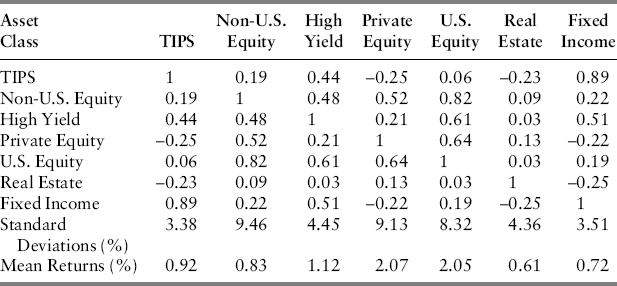Empirical Results
The naïve covariance estimates, which are equivalent to unconditional MLE for individual returns series but use the truncated series to estimate covariances are presented in Table 22.2. The set of corrected MLE returns, presented in Table 22.3, are the product of a two-step procedure in which we first remove the effects of smoothing from Private Equity and Real Estate returns by applying the Fisher-Geltner transformation outlined in Appendix 22.1. The covariance matrix was then estimated with a recursive application of Stambaugh's methodology in the following way:
Table 22.3 Corrected Correlation Matrix, Standard Deviations, and Mean Returns (Quarterly)

Return series were organized in descending order of length. The longest—fixed income, which dates to 1975—was used to estimate its own mean and variance. The next-longest series, real estate (unsmoothed), was then regressed against fixed income and the results were then used to update the conditional mean for real estate and its covariance with fixed income as given by equations (22.6) and (22.7). The returns to fixed income and real estate then constitute a matrix of instruments on which successively shorter returns series are regressed recursively, with covariances being revised according to equations (22.6) and (22.7). At the end of each recursion, the matrix of instruments is expanded once again. The new matrix ...
Get Investment Theory and Risk Management, + Website now with the O’Reilly learning platform.
O’Reilly members experience books, live events, courses curated by job role, and more from O’Reilly and nearly 200 top publishers.

